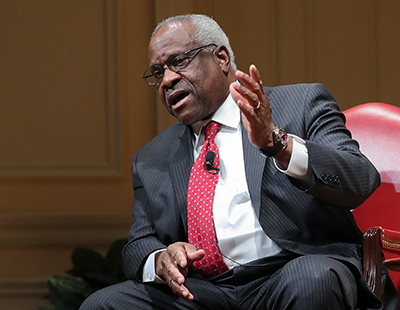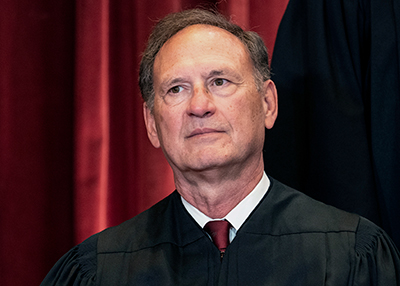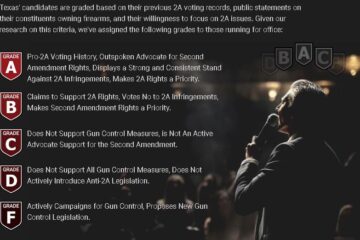What This U.S. Supreme Court Decision Will Mean for America
The U.S. Supreme Court invalidated New York’s “good-cause” requirement to exercise the right to bear arms in New York State Rifle & Pistol Association v. Bruen in a 6-3 decision on June 23, 2022. Justice Clarence Thomas, writing the opinion for the Court, ruled that the Second Amendment protects the right to carry a handgun for self-defense outside the home. Every law-abiding citizen is now eligible for a carry permit.
The lower courts have been waging massive resistance to the Supreme Court’s decisions in D.C. v. Heller and McDonald v. Chicago—decisions more than a decade old. In those cases, the Court held, respectively, that the right to keep and bear arms is an individual right and that it prohibits local, state and federal infringement. The Court read the Second Amendment to mean what it says and to say what it means, according to its original public understanding. In other words, Justice Thomas wrote, “[W]hen the Second Amendment’s plain text covers an individual’s conduct, the Constitution presumptively protects that conduct.” To justify a restriction, “the government must demonstrate that the regulation is consistent with this Nation’s historical tradition of firearm regulation.”
To get around this clear ruling, many lower courts invented a second “balancing test” to deconstruct the right and to thus uphold each and every restriction. Also called “intermediate scrutiny,” it was nothing more than a version of the deferential interest-balancing test Justice Stephen Breyer advocated in his Heller dissent, which the Heller majority rejected. “Despite the popularity of this two-step approach, it is one step too many,” wrote Justice Thomas in Bruen. What this means is that courts should consider the Second Amendment’s text and early history, not the “means-end scrutiny” that allows the supposed government interest to negate the natural right; as a result, virtually every lower-court ruling based on part two of the supposed test is now up for grabs.
- Activate Your Own Stem Cells & Reverse The Aging Process - Choose "Select & Save" OR Join, Brand Partner & Select Silver To Get Wholesale Prices
- Get your Vitamin B17 & Get 10% Off With Promo Code TIM
- How To Protect Yourself From 5G, EMF & RF Radiation
- Protect Your Income & Retirement Assets With Gold & Silver
- Grab This Bucket Of Heirloom Seeds & Get Free Shipping With Promo Code TIM
- Here’s A Way You Can Stockpile Food For The Future
- Stockpile Your Ammo & Save $15 On Your First Order
- Preparing Also Means Detoxifying – Here’s One Simple Way To Detoxify
As to the merits, nothing in the text of the Second Amendment restricts the right to “keep” arms in the home, as this would obliterate the other half of the liberty: the right to “bear arms.” As noted in Bruen, “Most gun owners do not wear a holstered pistol at their hip in their bedroom or while sitting at the dinner table.”
As to the “good-cause” requirement under which New York has limited permits to celebrities, the wealthy and those who paid the right bribes—and yes, that did happen—this amendment’s status as a constitutional right precludes mother-may-I-schemes. “We know of no other constitutional right that an individual may exercise only after demonstrating to government officers some special need,” wrote Justice Thomas.

History was Set Straight
To get its way, New York appealed to historical sources from medieval times through the twentieth century to argue that precedents exist for its carry ban. Yes, oppressive kings sometimes disarmed subjects, but isn’t that why we have the Second Amendment? New York neglected to include as a precedent the actions of George III, whose attempt to disarm the Americans sparked our Revolution. As Justice Thomas wrote, “[W]hen it comes to interpreting the Constitution, not all history is created equal. ‘Constitutional rights are enshrined with the scope they were understood to have when the people adopted them.’”
Instead of looking at the intent of James Madison and the other Founders in drafting the Second Amendment, New York would rely on the intent of King Edward III in passing the Statute of Northampton of 1328. “Notwithstanding the ink the parties spill over this provision, the Statute of Northampton—at least as it was understood during the Middle Ages—has little bearing on the Second Amendment adopted in 1791,” wrote Thomas.
Spilled ink is right. For over a decade, Bloomberg-financed research has promoted a revisionist history of an all-pervading Northampton rule that peaceably carrying arms without “the king’s license” has always been illegal. As Justice Thomas correctly points out, in Sir John Knight’s case of 1686, the English court ruled that going armed was an offense only if done in a manner “to terrify the King’s subjects.”
Perhaps misled by the revisionists, Justice Breyer suggested in his dissent that Knight was acquitted because he “based his defense on his loyalty to the Crown, not a lack of intent to terrify.” That disregarded what the English court actually said and the further fact that the Crown had Knight prosecuted because he opposed the Crown’s policies. The Crown was none other than James II, whose disarming of the protestant subjects sparked the Glorious Revolution in England. That resulted in the adoption of the Declaration of Rights of 1689, which declared that “Protestants … may have Arms for their Defence,” and so became the predecessor of the Second Amendment.
In the colonial and founding periods, peaceably going armed was lawful. In the early republic, a minority of states banned concealed carry, but that was upheld because open carry was legal. For a current restriction to be valid, it must be analogous to regulations that were generally accepted as constitutional when the amendment was adopted, as that is the will of the people. When slavery was abolished and the “Black Codes” sought to disarm the freedmen, the Fourteenth Amendment was ratified in 1868 in part to protect Second Amendment rights from state infringement, which were aimed primarily at African Americans. The scope of the right was considered basically the same in that period as in the Founding.
But New York’s Sullivan Law, enacted in 1911, teaches us nothing about the original public understanding. Not to mention that “to the extent later history contradicts what the text says, the text controls.” Consider that rule, oh mighty Ninth Circuit! In Peruta, you upheld discretionary licensing because you said the Second Amendment doesn’t protect concealed carry. And in Young, you upheld Hawaii’s carry ban because you said the Amendment doesn’t protect open carry, either. Bruen pulls the rug out from under your anti-textual “reasoning.”

The Fight Over the Details
The Court does recognize “longstanding” laws forbidding the carrying of firearms in “sensitive places,” such as schools, government buildings, legislatures, polling places and courthouses. But such places must be narrowly defined: “Put simply, there is no historical basis for New York to effectively declare the island of Manhattan a ‘sensitive place’ simply because it is crowded and protected generally by the New York City Police Department.”
But, as this was being written, New York Gov. Kathy Hochul (D), who, like all public officials at her level, is protected by armed bodyguards, was already working to negate the “frightful” Bruen decision by planning to ban firearms in places, like subways, where they are most needed by law-abiding citizens and to jack up permit-qualification requirements.
Manhattan District Attorney Alvin Bragg (D), who is reluctant to prosecute violent criminals, stated that “my office is analyzing this [Bruen] ruling and crafting gun-safety legislation that will take the strongest steps possible to mitigate the damage done today.” Does Bragg want to victimize the victims all the more? As the amicus brief in this case from the Black Attorneys of Legal Aid exposed, many otherwise law-abiding black and brown residents of New York have been incarcerated for attempting to defend themselves.
This U.S. Supreme Court decision does not address bans on modern rifles (the political term “assault weapon” does not appear), but it reaffirms the Heller rule that the Second Amendment “protects the possession and use of weapons that are ‘in common use at the time.’” AR-type rifles are indisputably in common use. After Heller was decided, in Heller II, we challenged the District of Columbia’s ban on semi-automatic rifles. Ruling that they are in common use and therefore protected by the Second Amendment should have been a no-brainer, as the majority admitted these firearms are commonly owned. But the court nevertheless upheld the ban based on part two of the “two-part” test that Bruen now rejects. Then-Judge Brett Kavanaugh dissented on the basis that the ban violated the Second Amendment.
All of the circuits to uphold rifle bans conceded that the banned firearms passed the first part of the test—they are, after all, “bearable arms” per Heller—except for the Fourth Circuit in Kolbe v. Hogan. That court made the absurd claim that AR-15 semi-automatics are “like” M-16 full automatics and thus may be banned. They saw no legal difference between a rifle that fires only one shot per trigger pull and a machine gun. This was truly an “emperor has no clothes” moment.
So, while Bruen doesn’t go into that issue, Justice Thomas did write that while “the Second Amendment’s definition of ‘arms’ is fixed according to its historical understanding, that general definition covers modern instruments that facilitate armed self-defense.”
This is a National Ruling
While the specific ruling is against New York, the Court called out the other five states with equivalent restrictions that are now invalid—California, Hawaii, Maryland, Massachusetts and New Jersey. All six states must now consider their “good-cause” factor to be crossed out and issue carry permits according to the other existing procedures. No need exists to wait until their legislatures repeal portions of laws now ruled to be unconstitutional.
The California attorney general released an alert that “issuing authorities should no longer require proof of good cause for the issuance of a public-carry license.” However, he said, they should thoroughly investigate an applicant, including a search of social media, to decide if the person has “good moral character.” New Jersey’s attorney general announced that “justifiable need” would no longer be a reason to deny a permit, but “good moral character” is still required. The danger exists that ideological tests may follow, which would violate both the First and the Second Amendments.
As of the time of this writing, the attorneys general of Hawaii, Maryland, Massachusetts and New York had issued terse denunciations of the decision.
As the Court notes, some 43 states have “shall-issue” permit systems. Three of those states—Connecticut, Delaware and Rhode Island—have discretionary language in their laws, but in practice they operate as “shall-issue.” Vermont does not issue permits, but neither does it require a permit for open or concealed carry. So that makes a total of 44 states that recognize the right of law-abiding citizens in general to bear arms.
Bruen does not question the various other requirements for carry permits, such as background checks, which were not challenged; however, “because any permitting scheme can be put toward abusive ends, we do not rule out constitutional challenges to shall-issue regimes where, for example, lengthy wait times in processing license applications or exorbitant fees deny ordinary citizens their right to public carry.” Left unsaid is that New York allows up to six months to act on a carry-permit application, which requires a fee of hundreds of dollars.

The Concurring Opinions
Concurring opinions were written by three justices, all agreeing with the opinion by Justice Thomas but adding further points. The dissent argued that the case should be remanded to the lower court for trial, to find out whether it is really so hard for a New Yorker to get a carry permit.
As Justice Samuel Alito responded, the record “tells us everything we need on this score.” The very words of the New York law and judicial decisions thereon make clear that “proper cause” does not include living in a high-crime neighborhood. He noted that amicus briefs were filed “by members of groups whose members feel that they have special reasons to fear attacks,” including the brief for the National African American Gun Association that counsel Nezida Davis and I filed.
Justice Brett Kavanaugh, with whom Chief Justice John Roberts joined, pointed out that “43 States employ objective shall-issue licensing regimes,” such as fingerprinting, a background check and training. That word “objective” will gain added significance if rogue states try to substitute ideological tests for “good moral character,” a covert way of reviving the subjective “proper-cause” criteria.
In her concurrence, Justice Amy Coney Barrett noted the scholarly debate on whether the scope of the right to bear arms should focus on when the Second Amendment was ratified in 1791 or when the Fourteenth Amendment, which made the Amendment applicable to the states, was ratified in 1868. She cautioned that the Bruen decision “should not be understood to endorse freewheeling reliance on historical practice from the mid-to-late 19th century to establish the original meaning of the Bill of Rights.” That’s good advice, because more restrictions began to appear late in the 19th century, and they were inconsistent with the original public understanding.
The Dissents and What’s to Come
Predictably, Justice Stephen Breyer, joined by Justices Elena Kagan and Sonia Sotomayor, dissented. The dissent goes on and on about criminals who murder victims with firearms, as if that didn’t prove the need for law-abiding citizens to protect themselves. Justice Alito asked “how does the dissent account for the fact that one of the mass shootings near the top of its list took place in Buffalo?” The dissent also makes the frankly weird argument that Bruen is in conflict with Heller, from which Justice Breyer also dissented.
Now that the U.S. Supreme Court has fully recognized the right to bear arms, much work lies ahead. When Heller threw out the District of Columbia’s handgun ban, the District defiantly enacted new, arbitrary restrictions to get revenge against gun owners. Some of them were invalidated in the case known as Heller III. As we go to print, the six nanny states whose “may-issue” laws are now declared to be unconstitutional are already scheming new restrictions on the right to carry, not to mention other rights basic to gun ownership. Americans must remain ever-vigilant to stop violations of their rights from every quarter.
Stephen P. Halbrook (stephenhalbrook.com) is a senior fellow with the Independent Institute and the author of 10 books, including The Right to Bear Arms: A Constitutional Right of the People or a Privilege of the Ruling Class?
Article by STEPHEN P. HALBROOK














